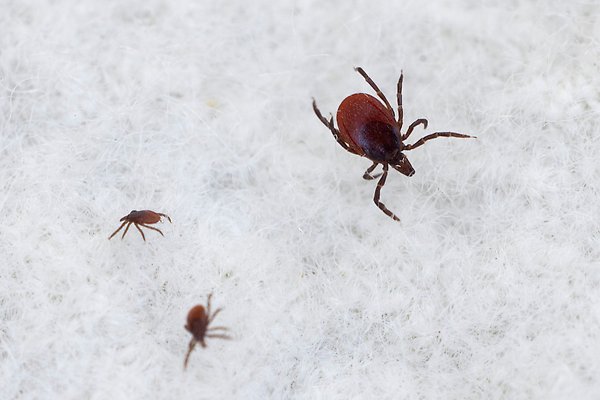Negligent not to warn about ticks
Researcher profile

Thomas Jaenson has been researching ticks since the 1980s. According to his calculations, there is a risk of many TBE cases this year unless it is a dry summer. Photo: Mikael Wallerstedt
He has 10,000 ticks in a freezer and is one of the media’s frequently hired experts on the subject. Professor Thomas Jaenson has dedicated the last 40 years to studying ticks and the diseases they can pass on to us. He is convinced that they carry many more pathogens than we are currently aware of, and thinks that the authorities ought to step up and warn people about ticks in high-risk areas for tickborne encephalitis (TBE).
Capturing them is easy. Thomas Jaenson draws a pale woollen blanket over the grass, turns it over and collects the little critters. This is what he has been doing since the 1980s – travelling around to different places in Sweden to map the tick’s range and studying the different disease-causing or pathogenic microbes that they can carry.
Right now, it looks like it will be a good year for Ixodes ricinus, the common tick – a species with a good sense of smell and taste that in the larval stage sucks blood from small mammals. This is also when they are at risk of becoming infected with borrelia bacteria and TBE viruses, which they can then transfer to us in their nymph stage.
“Last year there were high numbers of small rodents and this usually means that we get many TBE-infected nymphs the following year. Unless we have a very dry summer, we can probably count on many TBE cases this year,” says Thomas Jaenson, professor emeritus of medical entomology at Uppsala University.
Climate change and deer behind the increase
It was after the fox mange outbreak in the 1980s and 1990s that the number of ticks in Sweden began to rise. When the fox population declined, an important predator for the ticks’ host animals, roe deer and small rodents, disappeared. The warmer climate has also led to more ticks and host animals surviving the winter.
“The vegetation period has lengthened due to climate change. A milder climate is favourable to roe deer, the host animals of ticks, which now have better rates of survival over winter than before. We have never had as many mammals on land as we have now,” says Thomas Jaenson.

The tick goes through four different stages in its development: from egg to larva to nymph and then to adult tick. At every active stage, it sucks blood. The picture shows two nymphs and an adult specimen of Ixodes ricinus, the common tick. Photo: Mikael Wallerstedt
Sweden’s hunters not impressed
Thomas Jaenson identified early on that roe deer and other deer play an important role in the spread of ticks and the diseases they carry. Infections such as borrelia and TBE come from small rodents, but it is mainly from roe deer that adult female ticks get their last blood meal which means they can produce many eggs. When Thomas Jaenson stated in the media more than ten years ago that we should reduce roe deer numbers to get control of the spread of this infection, his remarks attracted criticism. It came mainly from some hunters who opposed his proposal. In the comments section, at times the tone became quite heated.
“Roe deer are a major, indirect cause of why so many people get sick. And I still stand by that today. But when the article was published, two people wrote in the comments that it was me who should be shot, not the roe deer.
However, Thomas Jaenson remains critical of the large numbers and the fact that roe deer have been introduced in places such as Gotland. Over the past decade, he has collected around 10,000 ticks that he now stores in a freezer pending analysis. Many of them come from Gotland, and he hopes to be able to analyse them to see how the spread of infection correlates with the dispersion of roe deer. Another plan for this large collection is to compare tick prevalence and tick-borne diseases between different biotopes.

At the age of four, Thomas Jaenson already had a free pass to the Museum of Natural History in his then home city of Gothenburg. Before his research came to be about ticks, he studied tsetse flies in Kenya and malaria mosquitoes in Guinea-Bissau. Photo: Mikael Wallerstedt
Ticks can carry a variety of viruses, bacteria and parasites
It's important to take the increase in tick numbers and the diseases they can spread seriously according to Thomas Jaenson. They can carry viruses and bacteria as well as various single-celled parasites that can make us sick.
“There are some doctors and other scientists who think that you shouldn’t exaggerate the dangers of ticks and have tried to play down the fact that a tick can be infected with many different pathogenic viruses and microorganisms.”
In a recently published study in which Thomas Jaenson and colleagues examined bat ticks from Norduppland, they were able to find 16 different virus species. Of these, 15 were previously unknown to science. Although it is widely known that there are very many viruses we have not yet discovered, the researchers were still surprised to find so many new ones. One of the species had been described earlier, but was completely new to Sweden.
“It was first found by Russian scientists in Kyrgyzstan and can cause a fever in humans,” says Thomas Jaenson, adding that the new virus species found are not necessarily pathogenic to humans.
In addition to viruses, bat ticks also carry various bacteria. When they were analysed, it became clear that a species of borrelia not previously seen in Sweden had been found.

The bat ticks were collected by Lars-Eric Roxin who built the nest on the right in the picture. The study was conducted by Thomas Jaenson together with John Pettersson, Uppsala University, Peter Wilhelmsson, Linköping University and colleagues in Australia. Photo: Peter Wilhelmsson and Lars-Eric Roxin.
Although it may sound scary, we should not be particularly worried, as bat ticks rarely bite people. The findings illustrate, however, how great the number of viruses and bacteria can be. In the study, all ticks that were analysed, around 160, came from the same bat nest.
Chronic borrelia could be another infection
The common tick that bites humans can also carry several different kinds of pathogens. Thomas Jaenson believes that this may be one of many reasons why some people infected by borrelia continue to be sick. When the doctor finds the characteristic bull’s eye redness around the bite or takes a test that shows borrelia, usually no more tests are done.
“It could be that they also have a virus, another bacterium or protozoa, which the antibiotic has no effect on. This is more common than some doctors think. It is the rule rather than the exception that ticks carry co-infections that are contagious.
Most co-infections are probably not pathogenic, or so low-pathogenic that the immune system takes care of them But for older people and other people with a compromised immune system, these can also be dangerous.

Thomas Jaenson recommends tick protection in the form of wellington boots and light-coloured clothing. If you want to discourage the ticks further, you can spray mosquito repellent with lemon eucalyptus oil on the lower legs of your trousers. Photo: Mikael Wallerstedt
The authorities should take more responsibility
Although Thomas Jaenson has been finding and catching ticks for 40 years, he has only been infected with borrelia once and it was easily remedied with a course of penicillin. However, he is careful to protect himself and recommends Wellington boots, short sleeves and light-coloured clothes that make it easy to spot and brush off any ticks or other bugs. Those who are in high-risk areas for TBE should also be vaccinated against the disease.
In 2021, a record number of TBE cases was recorded in Sweden, when as many as 534 people became ill. Many of these are at risk of permanent effects on their health. Thomas Jaenson believes that eradicating ticks is impossible. But there are other things that can be done to reduce the risk. He refers to Austria as an example, where a large part of the population has been vaccinated, and signs have been erected in certain tick-dense nature areas to warn against TBE. Something he thinks should be done in Sweden.
“I think the authorities should erect similar signs here, for example, next to high-risk areas for TBE in the Stockholm archipelago and in places like Lisö and Torö where many people have become ill. It feels negligent that there is not better information about TBE, especially in places visited by people from other countries who do not know that the risk is high.
Sandra Gunnarsson
Thomas Jaenson
Age: 74
Title: Professor emeritus of biology, specialising in medical entomology, at Uppsala University.
Family: Children Emma and David, grandchildren Tore, 2.5 years old and Alva 6 months old.
Hobbies and interests: My grandchildren, keep-fit classes, mountain biking and bird watching.
Currently reading: Hur tänker din katt? (What does your cat think?) by Bo Söderström.
What makes me smile: My children and grandchildren.
What makes me angry: When people lie, fake news and Putin’s atrocities.
What engages me: Ukraine
This is how to protect yourself from ticks
- Wear wellington boots and light-coloured clothes that make the ticks easy to spot. Avoid long-sleeved shirts where they can creep in unseen.
- Use mosquito repellent on the lower legs of your trousers, such as a variety that contains lemon eucalyptus oil.
- Check your entire body when you get home – even your groin area. Use two mirrors to see properly. Comb through your hair with a comb.
- Get vaccinated against TBE.
- Remove any ticks as soon as you detect them. The longer a TBE-infected tick is attached, the higher the viral content it can inject into you. The larger the dose, the higher the risk of getting sick. A borrelia-infected tick has the bacteria in its gastrointestinal tract, where it can take longer, usually at least 24 hours, before the bacteria spread.
